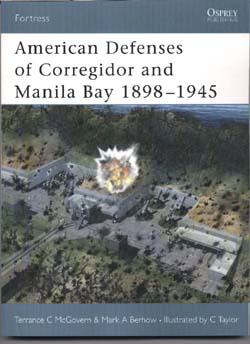 American Defenses of Corregidor and Manila Bay 1898-1945 American Defenses of Corregidor and Manila Bay 1898-1945
Fortress 4
By Terrance C. McGovern & Mark A. Berhow
Illustrated by C. Taylor
Osprey Publishing Ltd, 2003
ISBN 1-84176-427-2
64 Pages, Softbound When America took over the Philippine Islands Manila Bay was an obvious fleet base, and its fortification began then so this book also starts in 1898. The various gun emplacements were designed to defend against a fleet attack and were excellent for that purpose, though not updated as they should have been due to defense cuts – sound familiar? Nevertheless they served well, and even heavy Japanese artillery fire from the mainland only forced the abandonment of a few positions in 1942. The real problem was that most positions were incapable of firing against a land attack, because it was never thought (until too late) that an enemy could successfully land elsewhere and attack from the “blind side”. Hmm, why do US scholars attack the British defense of Singapore which fell due to the same failure to appreciate the possibility of land attack? However, this is not a campaign history but a description of the fortifications and in that role it serves very well. All the gun positions are described, and most of them shown in the photographs and plates, and their actual armament is set out too. Cutaway plates show the layouts of Battery Cheney and of Fort Drum – created by cutting away most of el Fraile Island to replace it with concrete. Other plates show various battery positions. The book includes accounts of life in the garrison during the 1930s before moving on to the Japanese attack – in which it is made clear why Corregidor had to be surrendered. The US assault in 1945 to retake the Bay and its island fortifications is covered too, and both the Japanese and US attacks are supplemented by maps. A long final section chapter describes the battery locations and what remains in them today, accompanied by photographs of the few remaining guns. Recommended to all students of the Pacific War. | 








|